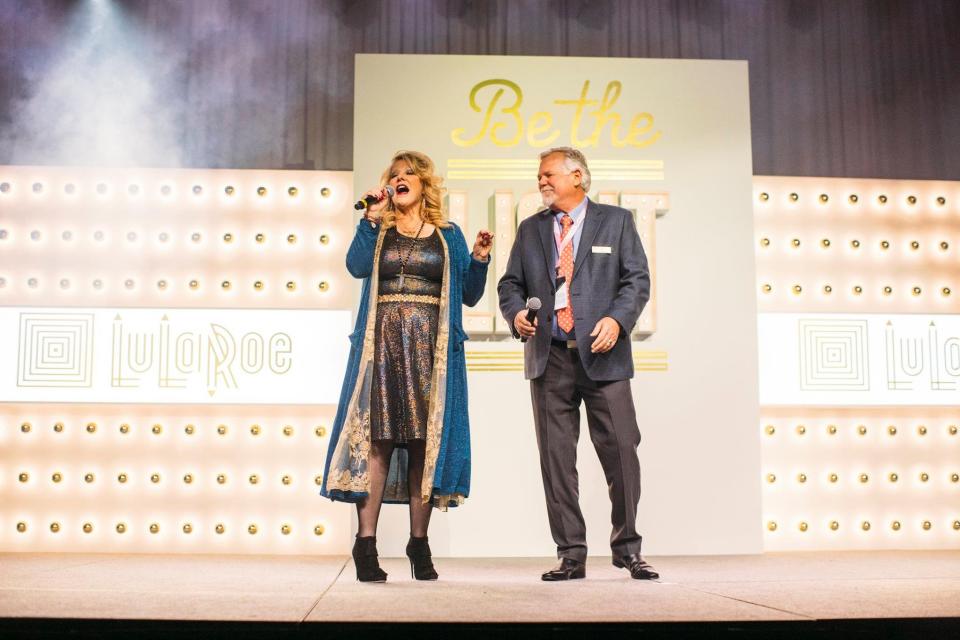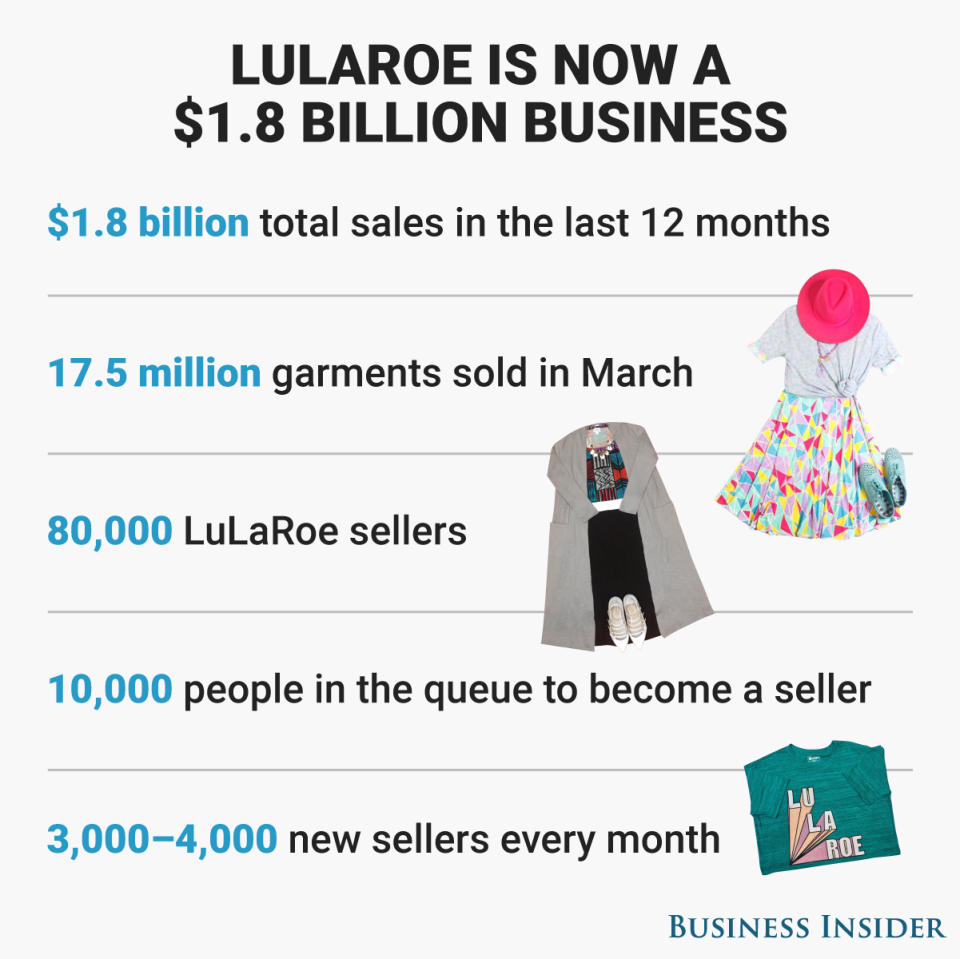LuLaRoe is refunding everyone for pants that customers say 'rip like wet toilet paper'

Instagram/@lularoe
LuLaRoe is launching a massive refund program in response to customer complaints that the company's leggings "rip like wet toilet paper" and develop holes after as little as a few hours of wear.
The 4-year-old company, which sold $1.8 billion in clothing in the last year, said Tuesday that it would issue full refunds for any defective merchandise purchased between January 1, 2016, and April 24, 2017.
Customers can get the refunds through the 80,000 people who sell LuLaRoe clothing — whom the company calls "independent retailers" — or directly from the company online.
LuLaRoe is also implementing a so-called happiness policy that's intended to make it easier for customers to get refunds, credits, or exchanges for purchases going forward.
"We listened and we heard the feedback from social media and our consumers and even from our retailers," LuLaRoe CEO Mark Stidham told Business Insider. "If someone has spent money on one of our products, we want them to feel that they got value for that money they spent."

Laura McIntyre
Business Insider reported in February that hundreds of customers were complaining about holes developing in leggings, which are LuLaRoe's most popular product.
Customers also claimed that many retailers — who buy clothing at wholesale prices from LuLaRoe and then sell it at a markup to friends and family on Facebook and at parties in their homes — wouldn't allow them to return defective merchandise.
At the time, a Facebook group devoted to sharing stories about the damaged leggings had more than 1,400 members. It now has more than 26,000 members.
One month after Business Insider's story, two LuLaRoe customers filed a class-action lawsuit accusing the clothing brand of ignoring customer complaints and knowingly selling defective clothes that "rip like wet toilet paper" to enrich the company's top executives.
Stidham says LuLaRoe's unhappy customers represent a tiny fraction of its total customer base.
"It's statistically insignificant — it doesn't exist," he said, comparing the several hundred complaints lodged against LuLaRoe on the Better Business Bureau's website with the 17.5 million garments that the company sold in March alone. "At the same time, I don't want to be flippant about that."
'I don't feel we have much to apologize for'
Stidham said the refund program and new policy did not represent an apology or a change of course for the company, but rather reinforced that LuLaRoe stands behind the quality of its products.
"I don't feel we have much to apologize for," he said. "I'm empathetic, and I'm sorry that [some customers] had a bad experience. But I don't feel that the company is in a place where a blanket apology is necessary."

Facebook/LuLaRoe
LuLaRoe's internal audits have shown that the merchandise damage rates are "very, very small," he said. "But no matter how small it is, if it's your piece of clothing and the bottom rips out of it, you are not going to be happy."
He said LuLaRoe would "always look for ways to improve quality and style," but that it was not changing its manufacturing process in response to the complaints.
The company has made changes, however, to its quality-assurance tests in the wake of the controversy.
"We've added different stretch tests and visual inspections to find small holes," he said. "We also invented a light-tower system where leggings can be stretched over it" to help detect any issues.
How LuLaRoe works
LuLaRoe has grown tremendously in the last several years. The number of people selling LuLaRoe products has jumped from 38,277 in September to 80,000 today, according to data obtained by Business Insider.

Skye Gould
The company expects to reach $1.8 billion in sales from April 2016 to the end of this month.
LuLaRoe has achieved this growth without selling any products in stores or even on a company website. Instead, the company sells clothing through its 80,000 independent retailers.
The retailers — many of whom are millennial moms — buy the clothing at wholesale prices and then sell them at marked-up prices to friends and in online forums.
The retailers can earn money from their direct sales and the sales of a team of recruits. This strategy is called multilevel marketing — though Stidham says he prefers "multilevel management" — and it's also used by companies like Mary Kay, Beachbody, and The Pampered Chef.
Some of LuLaRoe's top sellers say they make six-figure salaries.
One retailer, Tiffany Cook, posted a lengthy video online last year saying she earned about $34,000 a month with LuLaRoe. In the video, she says friends of hers make monthly bonus checks of between $9,000 and $20,000 from the company.
Another retailer told Business Insider last year that she sold 800 to 1,000 pieces of LuLaRoe clothing — about $80,000 worth — out of her home each month.

Instagram/LuLaRoe
But most sellers aren't as successful.
More than 80% of LuLaRoe's representatives generated less than $5,000 in sales last month, including 10,834 who sold nothing, according to data reviewed by Business Insider. The average representative sold about $3,387 worth of LuLaRoe in the month.
Stidham said the company didn't make any promises about how much money retailers could make selling its products. He said many retailers were content selling the clothes to friends and family for a little extra money, and that most didn't want to manage teams of sellers, which could generate more money.
How to get a refund
LuLaRoe's new policies include its Make Good program, which applies to purchases between January 1, 2016, and Monday, and its happiness policy, which applies to all future purchases.
The company also said it had sped up the process of refunding retailers who took back damaged items. In the past, retailers have complained that they couldn't get money back in a timely manner, but Stidham said that should no longer be the case.
Retailers were informed of the changes on Tuesday.
Here's a breakdown of each policy.
The Make Good program:
Applies only to purchases of defective merchandise made between January 1, 2016, and April 24, 2017.
Customers can apply for a replacement, gift card, or cash refund by contacting the retailer who sold them the product. If that retailer refuses to help them, they can contact LuLaRoe through its Make Good website, and the company will connect them with another retailer who can process their claim.
Customers can also apply for a refund in the form of a personal check or a LuLaRoe gift card by making a claim directly to LuLaRoe on its website.
Claims must be made no later than July 31, 2017.
The happiness policy:
Applies to purchases made on or after April 25, 2017.
Within 30 days of purchase, customers can return products for any reason to the retailer they purchased from to receive a full refund, credit, or exchange.
Within 90 days of purchase, customers can return products for any reason to any retailer to receive a credit or exchange.
Customers can also apply for a refund in the form of a personal check or a LuLaRoe gift card by making a claim directly to LuLaRoe on its website.
If a product has a manufacturing defect in materials or workmanship, customers may be entitled to a return at any time under the company's new limited warranty. The limited warranty applies to items purchased after April 24, 2017.
Customers will not be charged for return shipping.
NOW WATCH: People are outraged by a Pepsi ad starring Kendall Jenner — here's how the company responded
See Also:

 Yahoo News
Yahoo News 

